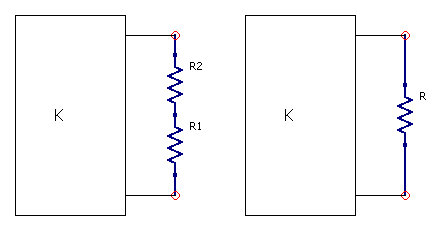FACT: When resistors \$R_1\$ and \$R_2\$ are connected in series, they can be replaced by an "equivalent" resistor \$R_1+R_2\$ (in the following I am using \$R\$ and subscripts to denote both the resistor and its resistance).
I am looking for a proof of this fact, but let me clarify what I know and what I am looking for.
I emphasize that I know the "proofs" in which you set up two circuits as in the following picture
and then write the mesh equation and conclude that \$R=R_1+R_2\$. I also know that the series combination on the left has the same \$v\$-\$i\$ characteristic as the single resistor on the right.
What I am looking for is more general and refers to the next picture.

Theorem. Let \$K\$ be any linear passive network with \$N\$ nodes and \$M\$ meshes. Call the node voltages in the left configuration \$v_n\$ and the current meshes \$i_m\$; call them \$u_n\$ and \$j_m\$ in the right configuration. Then: for each \$n\$ we will have \$v_n=u_n\$ and for each \$m\$ we will have \$i_m=j_m\$.
What I want is a proof of the above theorem (this is what I understand by the term "equivalent resistor".)
Here is a "proof-sketch" that I believe can be expanded to a full proof.
- In what follows \$K_1\$ is the left circuit of the second picture and \$K_2\$ is the right circuit.
- Write the matrix equations for mesh currents of \$K_1\$.
- Take any mesh which contains either of \$R_1\$ and \$R_2\$; since they are in series, either both are contained in the mesh or neither. Call the mesh current \$i_k\$.
- Any matrix coefficient multiplying \$i_k\$ will contain the sum \$R_1+R_2\$, since both resistors are contained in the mesh.
- Now write the matrix equations for mesh currents of \$K_2\$. The meshes of \$K_1\$ and \$K_2\$ are exactly the same, except that wherever \$R_1\$ and \$R_2\$ appear in \$K_1\$, \$R\$ appears in \$K_2\$. Also the sources appearing in a mesh of \$K_1\$ will be exactly the ones appearing in the corresponding mesh of \$K_2\$.
- In the \$K_2\$ equations replace the resistance \$R\$ with \$R_1+R_2\$. Now the equations for \$K_1\$ and \$K_2\$ are exactly the same and hence have exactly the same solution (same mesh currents).
- From equality of mesh currents follows equality of node voltages.
- Hence the two circuits are equivalent in the sense that all mesh currents and node voltages are the same. QED
Is the above correct? Is it overkill? Is there a simpler way? Any help will be greatly appreciated.
PS1: By a similar argument, using node voltage (rather than mesh current) equations we can prove the formula for parallel resistors.
PS2: I have looked for some proof of the above in many many circuit books, both introductory and advanced, and could not find it. I also searched similar topics in Stack Exchange; the closest I got was the following two
Defintion of equivalent circuit
Equivalent circuit and substitution
The answers proposed (as best as I understand them) were responding along the lines of connecting a single voltage source to the series resistors and the "equivalent" resistor and showing that voltage and current are the same in both cases. I repeat that I do understand this argument; what I am asking is a proof for the case in which an entire circuit is connected. I should add that the asker got little sympathy in the above referenced questions but, in my opinion, his original question and requests for clarification were entirely valid.




